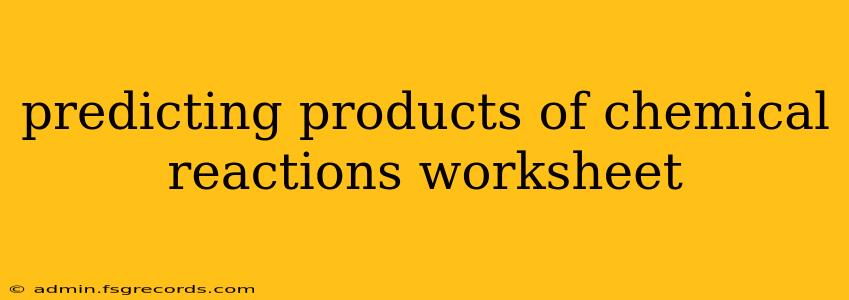Predicting the products of chemical reactions is a fundamental skill in chemistry. This worksheet will guide you through various reaction types, helping you master this crucial concept. Understanding reaction types allows you to move beyond simple memorization and develop a deeper understanding of chemical processes. We'll cover key concepts, provide examples, and offer strategies to tackle prediction problems effectively.
Understanding Reaction Types: The Foundation of Prediction
Before diving into predictions, let's review the common types of chemical reactions:
1. Synthesis (Combination) Reactions:
- Definition: Two or more substances combine to form a single, more complex product.
- General Form: A + B → AB
- Example: 2Na(s) + Cl₂(g) → 2NaCl(s) (Sodium and chlorine gas react to form sodium chloride)
2. Decomposition Reactions:
- Definition: A single compound breaks down into two or more simpler substances.
- General Form: AB → A + B
- Example: 2H₂O(l) → 2H₂(g) + O₂(g) (Water decomposes into hydrogen and oxygen gas)
3. Single Displacement (Replacement) Reactions:
- Definition: A more reactive element replaces a less reactive element in a compound.
- General Form: A + BC → AC + B
- Example: Zn(s) + 2HCl(aq) → ZnCl₂(aq) + H₂(g) (Zinc replaces hydrogen in hydrochloric acid) You'll need to refer to an activity series to predict these.
4. Double Displacement (Metathesis) Reactions:
- Definition: Two compounds exchange ions to form two new compounds. Often involves the formation of a precipitate, gas, or water.
- General Form: AB + CD → AD + CB
- Example: AgNO₃(aq) + NaCl(aq) → AgCl(s) + NaNO₃(aq) (Silver nitrate and sodium chloride react to form a silver chloride precipitate) Solubility rules are crucial here.
5. Combustion Reactions:
- Definition: A substance reacts rapidly with oxygen, often producing heat and light. Usually involves hydrocarbons reacting with oxygen to produce carbon dioxide and water.
- General Form: CxHy + O₂ → CO₂ + H₂O (unbalanced)
- Example: CH₄(g) + 2O₂(g) → CO₂(g) + 2H₂O(g) (Methane combusts in oxygen to produce carbon dioxide and water)
Strategies for Predicting Products
-
Identify the Reaction Type: Carefully examine the reactants. What type of reaction is most likely to occur?
-
Apply the General Form: Use the general form of the reaction type to predict the products.
-
Consider the Reactivity: For single displacement reactions, consult an activity series to determine if the reaction will occur.
-
Check Solubility Rules: For double displacement reactions, use solubility rules to determine if a precipitate will form.
-
Balance the Equation: Ensure the equation is balanced to satisfy the law of conservation of mass.
Practice Problems (Worksheet Section)
(Note: This section would contain a series of practice problems of varying difficulty, requiring students to predict the products of different chemical reactions based on the reaction types discussed above. Space would be provided for students to write their balanced chemical equations. Example problems are omitted here to maintain the markdown structure and to allow for unique problem creation suitable for the intended audience.)
Conclusion
Predicting the products of chemical reactions is a skill that improves with practice. By understanding the different reaction types and employing the strategies outlined above, you can confidently approach these problems and develop a stronger grasp of chemical principles. Remember to consult your textbook and other resources for additional examples and practice problems. Consistent practice will be key to mastering this essential skill in chemistry.

